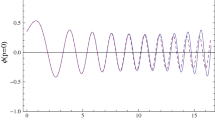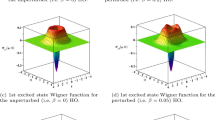Abstract
In this paper, we generalize the concept of Wigner function in the case of quantum mechanics with a minimum length scale arising due to the application of a generalized uncertainty principle. We present the phase space formulation of such theories following GUP and show that the Weyl transform and the Wigner function satisfy most of their known properties in standard quantum mechanics. We utilize the generalized Wigner function to calculate the phase space average of the Hamiltonian of a quantum harmonic oscillator satisfying deformed Heisenberg algebra. It is also shown that averages of certain quantum mechanical operators in such theories may restrict the value of the deformation parameter specifying the degree of deformation of Heisenberg algebra. All the results presented are for pure states. The results can be generalized for mixed states.


Similar content being viewed by others
References
W.B. Case, Wigner functions and Weyl transforms for pedestrians. Am. J. Phys. 76(10)(2008)
A. Kempf, G. Mangano, R.B. Mann, Hilbert Space Representation of the Minimal Length Uncertainty Relation. Phys. Rev. D 52, 1108 (1995)
M. Maggiore, Quantum groups, gravity, and the generalized uncertainty principle. Phys. Rev. D 49, 5182 (1994)
A. Kempf, Uncertainty relation in quantum mechanics with quantum group symmetry. J. Math. Phys. 35, 4483 (1994)
A. Kempf, Quantum group-symmetric Fock spaces with Bargmann–Fock representation. Lett. Math. Phys. 26, 1 (1992)
A. Kempf, Quantum group symmetric Bargmann–Fock space: Integral kernels, Green functions, driving forces. J. Math. Phys. 34, 969 (1993)
A. Kempf, Quantum Field Theory with Nonzero Minimal Uncertainties in Positions and Momenta. Preprint DAMTP/94-33, arXiv:hep-th/9405067 (1994)
F. Brau, F. Buisseret, Minimal length uncertainty relation and gravity quantum well. Phys. Rev. D 52, 1108 (2006)
M.-T. Jaeckel, S. Reynaud, Gravitational quantum limit for length measurements. Phys. Lett. A 185, 143 (1994)
A.P. Balachandran, G. Bimonte, E. Ercolessi, G. Landi, F. Lizzi, G. Sparano, P. Teotonio-Sobrinho, Finite quantum physics and non commutative geometry. Preprint ICTP: IC/94/38, DSF-T-2/94, SU-4240-567 (1994)
M. Maggiore, The algebraic structure of the generalized uncertainty principle. Phys. Lett. B 319, 83 (1993)
K. Konishi, G. Paffuti, P. Provero, Minimum physical length and the generalized uncertainty principle in string theory. Phys. Lett. B 234, 276 (1990)
D. Amati, M. Cialfaloni, G. Veneziano, Can space time be probed below the string size. Phys. Lett. B 216, 41 (1989)
E. Wigner, On the quantum correction for thermodynamic equilibrium. Phys. Rev. 40, 749–759 (1932)
M. Hillery, R.F. O’Connell, M.O. Scully, E.P. Wigner, Distribution functions in physics: Fundamentals. Phys. Rep. 106, 121–167 (1984)
H. Lee, Theory and application of the quantum phase-space distribution functions. Phys. Rep. 259, 150–211 (1995)
H. Weyl, The Theory of Groups and Quantum Mechanics (Dover, New York, 1931)
P. Bosso, Phys. Rev. D 97(12), 126010 (2018). https://doi.org/10.1103/PhysRevD.97.126010. [arXiv:1804.08202 [gr-qc]]
P. Bosso, [arXiv:2005.12258 [gr-qc]]
S. Das, M.P.G. Robbins, M.A. Walton, Can. J. Phys. 94(1), 139–146 (2016). https://doi.org/10.1139/cjp-2015-0456. [arXiv:1412.6467 [gr-qc]]
P. Bosso, S. Das, R.B. Mann, Phys. Rev. D 96(6), 066008 (2017). https://doi.org/10.1103/PhysRevD.96.066008
P. Bosso, S. Das, Ann. Phys. 396, 254–265 (2018). https://doi.org/10.1016/j.aop.2018.07.022
M. Bawaj, C. Biancofiore, M. Bonaldi, F. Bonfigli, A. Borrielli, G. Di Giuseppe, L. Marconi, F. Marino, R. Natali, A. Pontin et al., Nature Commun. 6, 7503 (2015). https://doi.org/10.1038/ncomms8503. [arXiv:1411.6410 [gr-qc]]
P.A. Bushev, J. Bourhill, M. Goryachev, N. Kukharchyk, E. Ivanov, S. Galliou, M.E. Tobar, S. Danilishin, Phys. Rev. D 100(6), 066020 (2019). https://doi.org/10.1103/PhysRevD.100.066020. [arXiv:1903.03346 [quant-ph]]
Author information
Authors and Affiliations
Corresponding author
Appendices
Appendix
A Uniqueness of Weyl transform and Wigner function
Our proof of the uniqueness of the definition of Weyl transform in QM following GUP is based on the assumption that the Weyl transform of the identity operator is unity. Keeping this in mind, we now introduce a general function \(f(x,p,u,\beta )\) and define the Weyl transform in deformed Heisenberg Algebra as :
Our assumption \(\tilde{I} = 1\) demands
The above integration can easily be done showing that
The above form of f does not depend upon x. Henceforth, we assume that in general f only depends on p and u. Now, we want our Weyl transform to satisfy the property
This is very important for our analysis based on the momentum states as it is the key equation to calculate the averages of observable. The left hand side of the above equation can be written as:
Integrating with respect to x we get a delta function
using which we can now write,
Defining new variables as \(p + \frac{u_{1}}{2} = v \) and \(p - \frac{u_{1}}{2} = y\) such that \(dp du_1 = dvdy\) the above expression transforms to
Now, the right hand side of Eq. (79) is
We know that if Eq. (81) is equal to the right hand side of Eq. (79), then from the last equation above we must have
The above equation yields
This equation provides three different possible forms of the function \(f(\beta ,p,u)\) as:
or
or
The Weyl transform of x (\(\tilde{x}\)) using the above forms of \(f(p,u,\beta )\) are given respectively by:
and
But, Weyl transform of observable (Hermitian operators) is purely real, so we can disregard the form of \(f(p,u,\beta )\) which produces complex Weyl transforms. Thus we get the unique form of the Weyl transform to be:
This is exactly the Weyl transform we have used in the paper.
B High momentum behavior of the Wigner function
Wigner function is given by :
Let power of p in the wave function \(\phi \) be m. Thus for large p, the Wigner function W(x, p) will go as \(p^{2m-2}\). Now, for harmonic oscillator, \(\phi \) takes the form :
where \(F\left( a_{n},-n,c_{n};\frac{1+i\sqrt{\beta }p}{2}\right) \) is the Hypergeometric polynomial function or order n. From these facts we can write \(m = n-2\sqrt{q+r_n} = n-2j\) where \(j \equiv \sqrt{q+r_{n}}=\frac{1}{2}\left( n+\frac{1}{2}\right) +\frac{1}{4}\sqrt{1+16r}\). Therefore \(W(x,p) \propto p^{2(n-2j)-2}\) in the high momentum limit.
Rights and permissions
About this article
Cite this article
Yeole, P., Kumar, V. & Bhattacharya, K. Wigner functions in quantum mechanics with a minimum length scale arising from generalized uncertainty principle. Eur. Phys. J. Plus 136, 174 (2021). https://doi.org/10.1140/epjp/s13360-021-01166-9
Received:
Accepted:
Published:
DOI: https://doi.org/10.1140/epjp/s13360-021-01166-9




